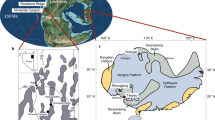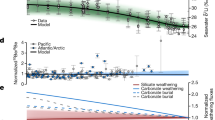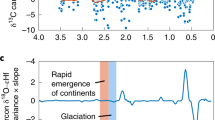Abstract
Ophiolite obductions in the tropics are coeval with Phanerozoic glaciations. The exposure of mafic and ultramafic rocks is thought to trigger cooling by increasing global weatherability. However, each Palaeozoic icehouse also coincides with a δ13C increase of 3−5‰, interpreted as an increase in organic carbon burial, not weatherability. Here we provide a framework that explains the tectonic forces behind Palaeozoic glaciations through increased organic carbon burial caused by the weathering of mafic and ultramafic lithologies in ophiolites. To evaluate the leverage ophiolite obduction has over organic carbon burial, we couple a mineral weathering model with a carbon box model. We show that the weathering of (ultra)mafic rocks can substantially enhance the preservation of organic carbon through the formation of high-surface-area smectite clays. The heightened organic carbon burial induced by an idealized ophiolite obduction causes ocean δ13C to increase by ~3.7‰. The temporal evolution and magnitude of our modelled δ13C excursion approximates Palaeozoic records. We present an analysis of shale geochemistry, which shows a correlation between ultramafic provenance and total organic carbon. Our results indicate that high-surface-area clays, formed during weathering of (ultra)mafic lithologies, exert a major control over Earth’s long-term carbon cycle.
This is a preview of subscription content, access via your institution
Access options
Access Nature and 54 other Nature Portfolio journals
Get Nature+, our best-value online-access subscription
$29.99 / 30 days
cancel any time
Subscribe to this journal
Receive 12 print issues and online access
$259.00 per year
only $21.58 per issue
Buy this article
- Purchase on Springer Link
- Instant access to full article PDF
Prices may be subject to local taxes which are calculated during checkout




Similar content being viewed by others
Data availability
Compiled SSA and TOC data are available in Supplementary Table 6. Geologic constraints are available in Supplementary Table 7. SGP data were downloaded on 3 October 2022, filtering for the following lithologies: shale, mudstone, siltstone. Iron and phosphorus data were downloaded from EarthChem on 19 March 2022, filtering all igneous rock analyses for which SiO2, FeO, and P2O5 are present. The igneous and sedimentary geochemical data are reproduced within the Supplementary Data and are available at https://doi.org/10.6084/m9.figshare.24433012.
Code availability
MATLAB functions are available for both the weathering model, weatherRock.m, and the carbon box model, carbonPhosphorusModel.m. The functions can be found at https://doi.org/10.6084/m9.figshare.24433012.
References
Owen, T., Cess, R. D. & Ramanathan, V. Enhanced CO2 greenhouse to compensate for reduced solar luminosity on early Earth. Nature 277, 640–642 (1979).
McKenzie, N. R. et al. Continental arc volcanism as the principal driver of icehouse–greenhouse variability. Science 352, 444–447 (2016).
Kump, L. R. et al. A weathering hypothesis for glaciation at high atmospheric \(p_{{\mathrm{CO}}_2}\) during the Late Ordovician. Palaeogeogr. Palaeoclimatol. Palaeoecol. 152, 173–187 (1999).
Galy, V. et al. Efficient organic carbon burial in the Bengal fan sustained by the Himalayan erosional system. Nature 450, 407–410 (2007).
Dessert, C., Dupré, B., Gaillardet, J., François, L. M. & Allegre, C. J. Basalt weathering laws and the impact of basalt weathering on the global carbon cycle. Chem. Geol. 202, 257–273 (2003).
West, A. J., Galy, A. & Bickle, M. Tectonic and climatic controls on silicate weathering. Earth Planet. Sci. Lett. 235, 211–228 (2005).
Jagoutz, O., Macdonald, F. A. & Royden, L. Low-latitude arc–continent collision as a driver for global cooling. Proc. Natl Acad. Sci. USA 113, 4935–4930 (2016).
Macdonald, F. A., Swanson-Hysell, N. L., Park, Y., Lisiecki, L. & Jagoutz, O. Arc–continent collisions in the tropics set Earth’s climate state. Science 364, 181–184 (2019).
Kump, L. R. & Arthur, M. A. Interpreting carbon-isotope excursions: carbonates and organic matter. Chem. Geol. 161, 181–198 (1999).
Grossman, E. L. et al. Glaciation, aridification, and carbon sequestration in the Permo–Carboniferous: the isotopic record from low latitudes. Palaeogeogr. Palaeoclimatol. Palaeoecol. 268, 222–233 (2008).
Hedges, J. I. & Keil, R. G. Sedimentary organic matter preservation: an assessment and speculative synthesis. Mar. Chem. 49, 81–115 (1995).
Lalonde, K., Mucci, A., Ouellet, A. & Gélinas, Y. Preservation of organic matter in sediments promoted by iron. Nature 483, 198–200 (2012).
Hemingway, J. D. et al. Mineral protection regulates long-term global preservation of natural organic carbon. Nature 570, 228–231 (2019).
Kennedy, M. J., Pevear, D. R. & Hill, R. J. Mineral surface control of organic carbon in black shale. Science 295, 657–660 (2002).
Harder, H. The role of magnesium in the formation of smectite minerals. Chem. Geol. 10, 31–39 (1972).
Nahon, D., Colin, F. & Tardy, Y. Formation and distribution of Mg, Fe, Mn-smectites in the first stages of the lateritic weathering of forsterite and tephroite. Clay Miner. 17, 339–348 (1982).
Brigatti, M. F. & Poppi, L. ‘Corrensite-like minerals’ in the Taro and Ceno valleys, Italy. Clay Miner. 19, 59–66 (1984).
Obeso, de, Carlos, J. & Kelemen, P. B. Major element mobility during serpentinization, oxidation and weathering of mantle peridotite at low temperatures. Phil. Trans. R. Soc. A 378, 20180433 (2020).
Velde, B. B. & Meunier, A. The Origin of Clay Minerals in Soils and Weathered Rocks (Springer, 2008).
Velbel, M. A. Constancy of silicate-mineral weathering-rate ratios between natural and experimental weathering: implications for hydrologic control of differences in absolute rates. Chem. Geol. 105, 89–99 (1993).
Blattmann, T. M. et al. Mineralogical control on the fate of continentally derived organic matter in the ocean. Science 366, 742–745 (2019).
Laakso, T. A. & Daniel, P. S. Regulation of atmospheric oxygen during the Proterozoic. Earth Planet. Sci. Lett. 388, 81–91 (2014).
Li, Y., Zhang, T., Ellis, G. S. & Shao, D. Depositional environment and organic matter accumulation of Upper Ordovician–lower Silurian marine shale in the Upper Yangtze Platform, South China. Palaeogeogr. Palaeoclimatol. Palaeoecol. 466, 252–264 (2017).
Percival, L. M. E. et al. Phosphorus-cycle disturbances during the Late Devonian anoxic events. Glob. Planet. Change 184, 103070 (2020).
Beil, S. et al. Cretaceous oceanic anoxic events prolonged by phosphorus cycle feedbacks. Climate 16, 757–782 (2020).
Löhr, S. C. & Kennedy, M. J. Organomineral nanocomposite carbon burial during Oceanic Anoxic Event 2. Biogeosciences 11, 4971–4983 (2014).
Sherwood, S. C., Bony, S. & Dufresne, J.-L. Spread in model climate sensitivity traced to atmospheric convective mixing. Nature 505, 37–42 (2014).
DeConto, R. M. et al. Thresholds for Cenozoic bipolar glaciation. Nature 455, 652–656 (2008).
Moore, C. M. et al. Processes and patterns of oceanic nutrient limitation. Nat. Geosci. 6, 701–710 (2013).
LaPorte, D. F. et al. Local and global perspectives on carbon and nitrogen cycling during the Hirnantian glaciation. Palaeogeogr. Palaeoclimatol. Palaeoecol. 276, 182–195 (2009).
Buggisch, W. & Michael, M. J. Carbon isotope stratigraphy of the Devonian of central and southern Europe. Palaeogeogr. Palaeoclimatol. Palaeoecol. 240, 68–88 (2006).
Stolfus, B. M. et al. An expanded stratigraphic record of the Devonian–Carboniferous boundary Hangenberg biogeochemical event from southeast Iowa (USA). Bull. Geosci. 95, 469–495 (2020).
Finlay, A. J., Selby, D. & Gröcke, D. R. Tracking the Hirnantian glaciation using Os isotopes. Earth Planet. Sci. Lett. 293, 339–348 (2010).
Percival, L. M. E. et al. Pulses of enhanced continental weathering associated with multiple Late Devonian climate perturbations: evidence from osmium-isotope compositions. Palaeogeogr. Palaeoclimatol. Palaeoecol. 524, 240–249 (2019).
Edmond, J. M. Himalayan tectonics, weathering processes, and the strontium isotope record in marine limestones. Science 258, 1594–1597 (1992).
Garver, J. I., Royce, P. R. & Smick, T. A. Chromium and nickel in shale of the Taconic foreland; a case study for the provenance of fine-grained sediments with an ultramafic source. J. Sediment. Res. 66, 100–106 (1996).
Hiscott, R. N. Ophiolitic source rocks for Taconic-age flysch: trace-element evidence. Geol. Soc. Am. Bull. 95, 1261–1267 (1984).
Workman, R. K. & Stanley, R. H. Major and trace element composition of the depleted MORB mantle (DMM). Earth Planet. Sci. Lett. 231, 53–72 (2005).
Viers, J., Dupré, B. & Gaillardet, J. Chemical composition of suspended sediments in world rivers: new insights from a new database. Sci. Total Environ. 407, 853–868 (2009).
Farrell, U. C. et al. The sedimentary geochemistry and paleoenvironments project. Geobiology 19, 545–556 (2021).
Broecker, W. S. & Peng, T.-H. Tracers in the Sea Vol. 690 (Lamont-Doherty Geological Observatory, Columbia Univ., 1982).
Bayon, G. et al. Accelerated mafic weathering in Southeast Asia linked to late Neogene cooling. Sci. Adv. 9, eadf3141 (2023).
Rosenthal, Y. et al. Site U1482. In Proceedings of the International Ocean Discovery Program: Western Pacific Warm Pool Vol. 363 (eds Rosenthal, Y. et al.) (IODP, 2018); publications.iodp.org/proceedings/363/363.PDF
Kennedy, M. J. & Wagner, T. Clay mineral continental amplifier for marine carbon sequestration in a greenhouse ocean. Proc. Natl Acad. Sci. USA 108, 9776–9781 (2011).
Kennedy, M., Droser, M., Mayer, L. M., Pevear, D. & Mrofka, D. Late Precambrian oxygenation; inception of the clay mineral factory. Science 311, 1446–1449 (2006).
Schrag, D. P., Berner, R. A., Hoffman, P. F. & Halverson, G. P. On the initiation of a snowball Earth. Geochem. Geophys. Geosyst. https://doi.org/10.1029/2001GC000219 (2002).
Rivero Crespo, M. A., Pereira Gómez, D., Villa García, M. V., Gallardo Amores, J. M. & Vicente, S. E. Characterization of serpentines from different regions by transmission electron microscopy, X-ray diffraction, BET specific surface area and vibrational and electronic spectroscopy. Fibers 7, 47 (2019).
Young, R. Soil Properties and Behaviour Vol. 5 (Elsevier, 2012).
Burton, M. R., Georgina, M. S. & Granieri, D. Deep carbon emissions from volcanoes. Rev. Mineral. Geochem. 75, 323–354 (2013).
Soulet, G. et al. Temperature control on CO2 emissions from the weathering of sedimentary rocks. Nat. Geosci. 14, 665–671 (2021).
Berner, R. A., Lasaga, A. C. & Garrels, R. M. Carbonate-silicate geochemical cycle and its effect on atmospheric carbon dioxide over the past 100 million years. Am. J. Sci. 283, 641–683 (1983).
Milliman, J. D. & Farnsworth, K. L. River Discharge to the Coastal Ocean: A Global Synthesis (Cambridge Univ. Press, 2013).
Kent, D. V. & Muttoni, G. Modulation of Late Cretaceous and Cenozoic climate by variable drawdown of atmospheric \(p_{{\mathrm{CO}}_2}\) from weathering of basaltic provinces on continents drifting through the equatorial humid belt. Climate 9, 525–546 (2013).
Syvitski, J. P. M., Charles, J. V., Kettner, A. J. & Green, P. Impact of humans on the flux of terrestrial sediment to the global coastal ocean. Science 308, 376–380 (2005).
Kuehl, S. A., Mead, A. A., Goodbred, S. L. & Kudrass, H. N. The Ganges–Brahmaputra Delta (SEPM, 2005).
Rudnick, R. L. & Gao, S. in Treatise on Geochemistry Vol. 3 (eds Holland, H. D. & Turekian, K. K.) 1–64 (Elsevier, 2003).
Gale, A., Colleen, A. D., Charles, H. L., Su, Y. & Schilling, J. ‐G. The mean composition of ocean ridge basalts. Geochem. Geophys. Geosyst. 14, 489–518 (2013).
Arrhenius, S. XXXI. On the influence of carbonic acid in the air upon the temperature of the ground. Lond. Edinb. Dublin Phil. Mag. J. Sci. 41, 237–276 (1896).
Stepanauskas, R. et al. Summer inputs of riverine nutrients to the Baltic Sea: bioavailability and eutrophication relevance. Ecol. Monogr. 72, 579–597 (2002).
Pacini, N. & Gächter, R. Speciation of riverine particulate phosphorus during rain events. Biogeochemistry 47, 87–109 (1999).
Frohlich, P. N., Bender, M. L., Luedtke, N. A., Heath, G. R. & DeVries, T. The marine phosphorus cycle. Am. J. Sci. 282, 474–511 (1982).
Hayes, J. M., Strauss, H. & Kaufman, A. J. The abundance of 13C in marine organic matter and isotopic fractionation in the global biogeochemical cycle of carbon during the past 800 Ma. Chem. Geol. 161, 103–125 (1999).
Acknowledgements
We thank D. Rothman and F. Macdonald for their insight, particularly in respect to the carbon cycle and its isotopic record. We thank M. Follows for a valuable discussion on dissolved oxygen and remineralization. Funding for this work came from NSF EAR 1925863.
Author information
Authors and Affiliations
Contributions
J.M. and O.J. conceptualized the research. J.M. led modelling and statistical methods. J.M. and O.J. were responsible for data analysis, writing and editing.
Corresponding author
Ethics declarations
Competing interests
The authors declare no competing interests.
Peer review
Peer review information
Nature Geoscience thanks Donald Penman, Thomas Blattmann and Germain Bayon for their contribution to the peer review of this work. Primary Handling Editors: James Super and Alison Hunt, in collaboration with the Nature Geoscience team.
Additional information
Publisher’s note Springer Nature remains neutral with regard to jurisdictional claims in published maps and institutional affiliations.
Supplementary information
Supplementary Information
Supplementary Figs. 1–18, Tables 1–5, Results and Methods.
Supplementary Data 1
Supplementary Data.
Rights and permissions
Springer Nature or its licensor (e.g. a society or other partner) holds exclusive rights to this article under a publishing agreement with the author(s) or other rightsholder(s); author self-archiving of the accepted manuscript version of this article is solely governed by the terms of such publishing agreement and applicable law.
About this article
Cite this article
Murray, J., Jagoutz, O. Palaeozoic cooling modulated by ophiolite weathering through organic carbon preservation. Nat. Geosci. 17, 88–93 (2024). https://doi.org/10.1038/s41561-023-01342-9
Received:
Accepted:
Published:
Issue Date:
DOI: https://doi.org/10.1038/s41561-023-01342-9



